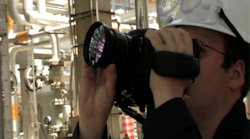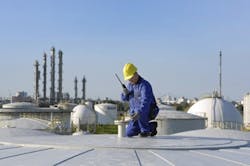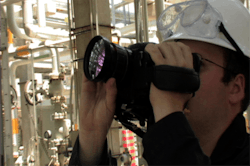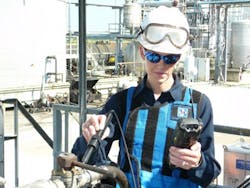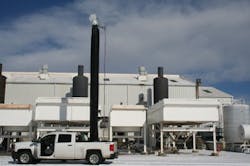Chemical companies such as BASF and Dow are working hard both to identify and deal with the sources of their fugitive emissions. Meanwhile, vendors such as Garlock and Honeywell Process Systems are developing technologies and procedures to make the job faster and more cost-effective.
Fugitive emissions may pose significant hazards to people and the environment as well as sizable economic penalties from loss of materials. “Fugitive emissions cause losses during production, transport and storage. Many of the substances concerned are toxic and it requires know-how and state-of-the-art technology to contain their release,” notes Christoph Moritz, coordinator air quality, BASF, Ludwigshafen, Germany.
To reduce fugitive — also known by BASF as diffuse — emissions, the company implements strategies at its sites that meet local, national and international standards. At the heart of these strategies are three basic rules.
[javascriptSnippet ]
First is avoidance. “Here, we use state-of-the-art equipment such as low-emission seals that have been designed for use with critical chemicals. We also run quality assurance programs for mechanics and operators, who are properly trained in special courses according to latest standards, for example, VDI 2290 in Germany,” he adds. (The VDI 2290 guideline deals with flange connections for liquid and gaseous media to meet emission control requirements; it covers various metals and applies to services with a maximum operating temperature of 400°C.)
“Besides regular inspection and maintenance, our plants are controlled by means of pressure drop sensors. Seals and flanges are replaced at defined intervals,” says Moritz.
Figure 1. Plant technician uses a flame ionization detector to check seals and flanges on a set schedule. Source: BASF.
The second basic rule is detection of emissions and leaks (Figure 1). Typically, plants rely on a conventional flame ionization detector (FID) that is sensitive to organic substances. Analysis of the substance begins at a pre-set threshold concentration, for example, 500 ppm. If such a concentration is exceeded, operating staff takes immediate action.
An infrared (IR) camera often serves as a preliminary detection device (Figure 2). Set in a “fume sensitive” mode, it can spot an increased concentration of a substance; a more precise check with an FID immediately follows.
“All plants are equipped with such sensors and any leaks detected are instantly repaired. The detection procedures themselves may vary from country to country depending on local regulations and the requirements of the respective authorities,” he explains.
The final basic rule is calculation of emissions; the methods used depend upon the relevant standards (EPA, DIN, etc.). To create a proper comparison between the different standards, BASF has carried out internal studies and sponsored several postgraduate research theses. “These have revealed valuable information about the correlation between ‘sniffed’ concentrations of organics and the corresponding leakages in g/h — i.e., mass flow. Moreover different methods of calculation for diffuse emissions were compared and quantified,” Moritz says.
Link to Sustainability
For Dow Chemical, Midland, Mich., reducing process spills from equipment and decreasing fugitive emissions are part of its overall sustainability strategy. Launched last year, its 2025 sustainability goals commit the company to maintaining world-leading operations performance in natural resource efficiency, environmental protection, health and safety.
To this end, Dow has set a goal to reduce severe process safety and containment events by 70% by 2025, a target the American Chemistry Council, Washington, D.C., suggests for its members. The company’s fugitive emissions strategy covers small emissions of gases or vapors from equipment flanges, seals and packing components that are difficult to detect without specialized equipment.
“Our current focus on reducing fugitive emissions centers on improving Dow’s leak detection and repair (LDAR) management system. This includes improvements to LDAR training, work processes, tracking tools, quality assurance and control and self-assessments. Additional improvements will focus on the technology used by contract providers,” notes a spokesperson.
Dow’s site in Lauterbourg, France, provides a prime example of this work in action: the plant has reduced process spills and associated emissions by 75% over the past four years.
The key driver of this change was an improvement project that focused on three main actions.
Figure 2. Readings from a camera can provide the first warning of a leak, and spur follow-up checks with a flame ionization detector. Source: Sage Environmental.
First, was having plant leadership set clear expectations about the reporting of actual and potential leaks and spills of any size. All such events require a root cause investigation and the assignment of corrective actions.
Second, was creating an improvement team to lead overall efforts and implement projects identified. These projects included rearranging equipment, using color-coded caps to distinguish hazardous from non-hazardous chemicals, labeling valves to indicate those that only should be opened in exceptional circumstances, and implementing checklists and double-checking by a second operator to ensure proper valve resealing.
The third action was ensuring that all operations team members — plant operators, engineers, maintenance and leadership — contribute to the reporting of leaks. This involved setting individual goals, measuring performance against these goals, and factoring participation in leak-reduction efforts into team member recognition and performance management.
To support the initiative, the site also upgraded its assets, e.g., replacing circle pumps with screw flasks, introducing valves that only can be opened by key, and installing leak detectors that can shut down equipment automatically.
Improving Technology
Advances in technology are helping chemical companies both to better identify the sources of their fugitive emissions and meet evolving legislative demands, says Jim Drago, principal applications engineer, Garlock, Palmyra, N.Y.
Identifying sources is critical, he notes, citing a 1997 study “Analysis of Refinery Screening Data” (Publication 310 of the American Petroleum Institute, Washington, D.C.) that found 90% of all such emissions coming from fewer than 5% of the 50,000 components subject to fugitive emissions compliance. This 5% included components with high magnitude leaks, typically greater than 10,000 ppm. “Consider the fact that the threshold for categorizing a component as leaking is usually 500 ppm and one asks the questions: ‘Why are we monitoring all these components that are not leaking or are small leaks? How can we identify the components with large leaks and eliminate 90% of our emissions?’”
One emerging technology is high-flow sampling. The current sampling techniques, designated in EPA Method 21, measure volatile organic compound (VOC) concentration at the probe’s end, which is fairly small — about ¼-in. in diameter (Figure 3). With high-flow sampling, the size of probe end is 1½–2-in. in diameter (similar to that of the hose of a household vacuum cleaner) and so takes in a much larger volume of sample of the ambient atmosphere around the equipment of interest. “This is accepted as being a full sampling of the entire leak, so it can be an easy leap to quantifying the leak in kg/h.,” notes Drago.
IR camera technology also taken a big leap forward, he says. Originally the cameras just were used to “see” leaks and were go/no-go instruments heavily dependent on factors such as the ambient atmosphere and wind conditions. They often were not accurate with leaks below around 2,500–5,000 ppm and sometimes weren’t even useful below 10,000 ppm, Drago explains.
“Companies such as Rebellion Photonics, Houston, Texas, have changed all that with gas cloud imaging (GCI) camera technology. This now gives you the ability [to] carry out continuous or mobile monitoring with a camera and immediately get a leak rate,” he says. The GCI camera (Figure 4) detects gases’ unique spectral signal, which enables advanced algorithms to identify specific hydrocarbon fingerprints within an emission; operators are immediately alerted to potential hazards on a site.
Figure 3. Current sniffing technologies for monitoring volatile organic compounds rely on a probe with a small diameter. Source: Team Industrial Services.
Meanwhile, seal manufacturers, including Garlock, are focusing on installation techniques. “We’re not seeing ‘OMG that’s new’ products for, for example, valve stem seals, which are the primary emission source on any plant. Rather, we are refining and tweaking what we do. At conferences and in discussions with customers, we are really stressing the importance of good installation practices and the quality of the installers themselves and the people who oversee them.”
Valve manufacturers and seal makers are engaging in much greater review of valve designs, says Drago. Both are becoming much more serious about getting certification to API 624 — a standard that specifies the requirements and acceptance criteria for fugitive-emission-type testing of valves.
Finally, he expects much of the open forum discussions and conferences this year to focus on what the next generation of LDAR regulation from the U.S. Environmental Protection Agency (EPA) will look like. “It seems they will be very much in line with its NextGen strategy,” he notes.
Running from 2014–2017, NextGen, which is the EPA’s plan to improve the effectiveness of its compliance program, brings together five interconnected components: easier-to-implement design regulations and permits; promotion of advanced emissions/pollutant detection technology; greater use of electronic reporting; increased transparency, making information more accessible to the public; and development and use of innovative enforcement approaches such as data analytics and targeting to achieve more-widespread compliance.
Wider Role For Wireless
Development of robust, cost-effective wireless technologies is helping companies achieve their goal of zero incidents, says Diederik Mols, global business leader industrial wireless solutions, Honeywell Process Solutions, Amsterdam, The Netherlands. “Every leak could lead to an incident; look what happened at Buncefield,” he stresses. (For details on the explosion at the Buncefield fuel depot in the U.K., see “It’s Time to Tank Complacency.”)
Since the incident at Buncefield, liquid leak detection has gotten much greater priority because of the dangers posed by explosive vapor clouds formed by fugitive emissions via evaporation from such spills, notes Mols. Tank roof monitoring also has become more a priority, firstly to avoid overfills and secondly to ensure that floating roofs are kept even to avoid gas vapor leaks, he adds.
Figure 4. Camera can identify specific hydrocarbons and also generate a leak rate. Source: Rebellion Photonics.
In addition, he has noticed that companies are getting much more stringent in their detection-to-alarm time demands. Here, he cites a customer in Qatar that runs one of the world’s largest integrated liquefied-natural-gas complexes. The company wanted a warning system to alert personnel in the administration area of any toxic gas leakage. One of the critical requirements was to generate audio and visual alarms within three seconds of detecting a gas leak — a demand that had proved the stumbling block for another vendor who could not meet the required latency period. Honeywell’s success lay in the use of its OneWireless infrastructure and the XYR 6000 Universal I/O wireless transmitter, which together enabled the rapid audio and visual alarming required.
Advances in personal gas detectors also are bolstering the protection of personnel from the danger of leaks. For instance, later this year, Honeywell plans to introduce new technology specifically designed to reduce the risks for operators working on their own in remote areas of the plant, such as tank farms or wastewater treatment facilities, or even outside the perimeter. It monitors vital functions, hazardous gas levels and whether or not an operator is down. Any alarms from the detector will be displayed and triggered in real time in the control room. “Not only do you get better gas-detection information, but also the system can be the difference between life and death for a field operator,” notes Mols.
The future of emissions detection technology lies in further miniaturization and improved cost-effectiveness of sensors — along with closer tailoring of the technology to the demands of regional legislation, he believes.
